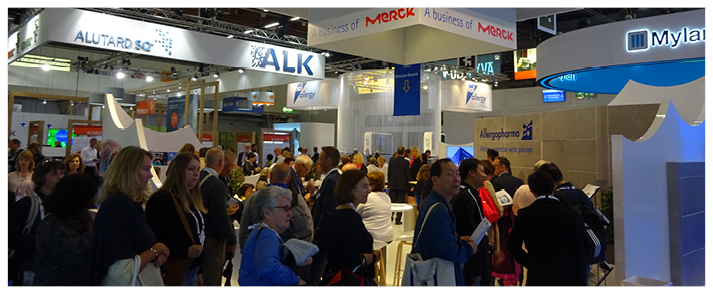The largest allergy congress in the world was this year hosted in the scenic city of Helsinki, Finland. The congress theme was ‘On the road to prevention and healthy living’, encapsulating the passion of the European Academy of Allergy and Clinical Immunology (EAACI) to create a better quality of life and lower disease burden for their patients.
The city of Helsinki provided the perfect setting for the congress, being known the world over for its modernity and its association with scientific prowess. The most recent Thomson Reuters list of Highly Cited Researchers was furnished with no fewer than 10 representatives of the University of Helsinki, out of the 17 researchers featured from across Finland. In 2015, a team, headed by Prof Kari Alitalo at the University of Helsinki, reported the discovery of lymphatic vessels in the brain, which has been hailed as one of the most significant scientific findings of the year. Indeed, this discovery has changed the way that we think about neurological diseases by showing the connection between the brain and the lymphatic system. Helsinki is also famous for its world-class research in climate change; the University of Helsinki was this year chosen as the prestigious headquarters of the Integrated Carbon Observation System (ICOS), and this will be closely followed in 2021 by the Aerosols, Clouds, and Trace Gases Research Infrastructure Network (ACTRIS). These are just some of the impressive accolades boasted by the beautiful city that attendees were encouraged to explore alongside the jam-packed scientific programme.
Continuing the theme of academic and scientific excellence, the EAACI congress utilised the very best in technological support. Audio accompaniments to poster sessions were available via an app, while delegates were also able to earn CME credits simply by entering the room in which a session was being held without the need to scan in. A computer chip synced with an attendee’s badge registered via wireless sensors mounted throughout the venue, offering attendees a convenient and fast way to earn CME credits and enjoy the congress without waiting in line to scan in.
The programme offered attendees the chance to take part in all aspects of allergy and immunology research and practice, and with such a broad range of activities, talks, and sessions to attend, there really was something for everyone. Postgraduate sessions offered medical students the opportunity to learn more about the practice of allergy and immunology, with training courses offered on topics such as managing drug hypersensitivity, adult food allergy, and ‘omic’ technologies; attendees could also take a short course in leadership to offer career advice and progression. Pro-Con debates featured throughout the event, and you can read about some of these in more detail in the following congress review, courtesy of our congress reporters. The schedule was peppered with symposia addressing a plethora of important issues in allergy and immunology, including treatment of rhinosinusitis, environmental and climate impact on allergic disease, and the much-anticipated Women in Science symposium.
Women in science is a subject of great importance for EAACI; EAACI president Prof Antonello Muraro was keen to note the achievements of EAACI in advocating for greater progression for women in science as well as the academy’s commitment to encouraging young talent in her presidential message in the congress newsletter. She explained: “EAACI now has 10,000 members and more than half of them are women. Our biggest group is the Junior Members assembly. We are a young academy facing a generational change, as well as generational and gender opportunities.” She was also optimistic and passionate about the future of the society: “EAACI is definitely the place to be if you have ideas and want to make them happen. The passion and vision are there, and I very much hope and wish that the academy’s members will continue to enjoy working together in the coming years.”
The opening ceremony welcomed attendees with a rousing rendition of classical piano by well-known Helsinki-born jazz musician, Iiro Rantala. Following this, Prof Muraro addressed delegates alongside Prof Antti Lauerma, the EAACI Congress 2017 Chair. Prof Lauerma talked of the journey to arranging the congress, explaining that: “Every member can suggest a topic or session” so that “The whole programme over the 18 months is the result of our membership’s suggestions.” It is this enthusiasm and hard work that makes EAACI arguably one of the most inclusive European congresses.
Another exciting and much-anticipated aspect of the congress was the poster presentation and discussion sessions. Posters and oral presentations were displayed throughout the event and prizes were awarded each day to the most impressive. The winners included studies on management of drug allergy, anaphylaxis, drug allergy: diagnosis, biomarkers in asthma, and insect venom allergy, with winners hailing from all four corners of the globe. Presenters of a selection of abstracts have provided the European Medical Journal with exclusive summaries of their research for your reading pleasure. Simply proceed to our Abstract Reviews section to learn about just some of the ground-breaking research that was presented at the congress, whether you are looking back on the congress or catching up on what you missed.
EAACI 2017 was certainly a congress to remember. We hope you will enjoy our independent review of the event and look forward to seeing you at next year’s event in Munich, Germany!

Call to Action: Allergy and Asthma
AN ISSUE especially promoted at the EAACI congress 2017 was the political Call to Action for European nations: ‘United action for allergy and asthma’. This Call to Action had been launched prior to the congress, on 25th April 2017. EAACI was one of three co-founders of this initiative. The other two founders were the European Federation of Allergy and Airways Diseases Patients’ Associations (EFA) and the European Parliament Interest Group on Allergy and Asthma. The co-founders intend that this initiative will kickstart an advocacy campaign that is European in scope to generate action to tackle two of the most prevalent chronic conditions in Europe: allergy and asthma (currently there are >220 million patients across Europe with allergy and asthma).
The Call to Action in Europe will focus its attention on both EU and national policymakers. Its overall goal is “to unite all strategic parties in Europe to address allergy and asthma through a collaborative and holistic approach, supporting patients’ rights.” Policy recommendations will be provided to stakeholders at all levels, ranging from patients to the European Parliament and EU member states.
Furthermore, it is hoped that, under the aegis of the Call to Action, increased collaboration between European countries can be fostered. This collaboration would involve better promotion of allergy and asthma programmes, greater support for the collection of public health measures, and increased co-ordination to monitor allergy and asthma-related trends across Europe. Another goal is for European countries to increase expenditure and investment on campaigns to prevent and detect allergy and asthma. These would include training programmes and awareness campaigns targeted at healthcare professionals.
It was noted at the EAACI congress that the first stage of the campaign was to collect signatures from all interested parties in order to show both support and the need for greater development in monitoring, preventing, and treating allergies and asthma. This signature-gathering stage culminates on 30th September 2017. Speaking at the launch event for the Call to Action, Sirpa Pietikäinen, Co-Chair, European Parliament Interest Group on Allergy and Asthma, offered an inspiring message, stating: “Change is possible, it needs to happen now, let us unite to drive positive change together.”
Pro-Con Debate: Macrolides Should be Considered for the Treatment of Asthma
THE MODERATOR Dr Ömer Kalayci (Turkey) introduced the two participants in the first of the Pro-Con debates that took place at the EAACI Congress on Sunday 18th June. In favour of the motion ‘Macrolides should be considered for the treatment of asthma’ was Dr Michael Edwards (UK), and opposing was Prof Vibeke Backer (Denmark).
Before the debate began, the audience was asked to vote on the motion put forward, utilising the EAACI Congress smartphone app. This vote found 78% in favour of considering macrolides for the treatment of asthma.
Dr Edwards began by defining what he meant by the word ‘consider’. “We should consider macrolides for the treatment of asthma. What I am not saying is that macrolides should replace inhaled corticosteroid therapy,” he clarified. Dr Edwards then presented a number of published studies that showed the potential for this type of treatment. With regard to stable asthma, he outlined the results from 11 adult and 3 paediatric trials. Of the 11 adult studies, 10 met their primary endpoint, and just over half met their primary endpoint plus at least one secondary endpoint. Additionally, two-thirds of the paediatric trials included in his analysis supported the use of macrolides in stable asthma.
He then discussed the role of macrolides in reducing asthma exacerbations, introducing four studies that achieved positive results. In one, for example, there was ˜40% reduction in severe asthma exacerbations through treatment with the macrolide azithromycin.
Finally, Dr Edwards displayed several studies showing the effects of macrolides in young children (aged 1–3 years) with asthma-like symptoms. In these there were excellent reductions in conditions such as lower respiratory tract infections; additionally, some particularly interesting information to emerge was that azithromycin, an antibiotic, is effective in viral disease. “Azithromycin may be doing something that we do not completely understand,” mused Dr Edwards.
He concluded with a positive message tempered by the need for greater understanding: “We have reasons for optimism. Clinical trials do show an effect. I think we need to consider what is the correct trial design and to look for a macrolide effect in asthma. And I think part of the reason is the challenges associated with designing the correct trial, because we do not understand the underlying biology very well.”
Prof Backer then made her counter-arguments. She began by pointing out that the data regarding macrolides in asthma are currently very limited. She also reminded the audience that quality of life is one of the most salient issues for asthma patients, and with regard to this particular measure, a number of studies had failed to show a positive effect. Indeed, there was consistently no difference in the medium effect between macrolides and placebo.
Similarly, the Danish professor discussed several studies that did not display any impact between patients on placebo or treated with macrolide in relation to mortality rates. An exception to this was in open label trials, when the patient knew they were receiving the treatment. In conclusion, Prof Backer was unequivocal: “My conclusion is there is no effect of macrolides in asthma treatment.”
In a 2-minute rebuttal, Dr Edwards then conceded that many more studies were required to fully understand everything that macrolides are actually doing, while reiterating what he saw as their great potential in contributing to the treatment of asthma. Prof Backer was not to be moved from her confirmed position, however, that macrolides should never be considered for asthma treatment.
To end proceedings, Dr Kalayci asked the audience to re-cast their votes. There was a narrowing of the gap from the first vote, with 63% in favour and 38% against, which brought the session to a close.

Pro-Con Debate: Can Drug Provocation be Done Without Skin Testing First?
ANOTHER of the exciting Pro-Con debates that featured throughout EAACI 2017 focussed on the topic of drug provocation and skin testing; views on whether skin testing prior to drug provocation is necessary were discussed. The session was chaired by Prof Andreas Bircher (Switzerland), with Dr Lene Heise Garvey (Denmark) advocating the position that skin testing is not strictly necessary before drug provocation and her opponent Dr Knut Brockow (Germany) defending the need to perform the tests.
The discussion was lively and informative, with speakers drawing on both personal experience and published studies to demonstrate their points. Prof Bircher opened the session by introducing the topic and reiterating that although drug provocation certainly could be done, the real question was should it be done. He began by asking the audience to participate in the live vote via their smartphone app to agree or disagree with the statement ‘Can drug provocation be done without skin testing first?’ and remarked that the results came out close to 50/50, setting the scene for a passionate debate.
As a consultant allergist in Copenhagen, Denmark, Dr Heise Garvey explained that her clinic performs 10–20 provocations per day. She began by defending the statement as the pro side of the debate, concentrating her argument on antibiotics as the most common cause of drug allergy. She acknowledged the tremendous pressure on healthcare professionals to see more patients in a shorter amount of time, as well as the need to reduce the number of tests being taken and the number of visits per patient to the clinic, something which also benefits the patient. However, she pointed out that what is always paramount is the safety of the treatment for the patient.
Dr Heise Garvey talked about the European Network for Drug Allergy (ENDA) guidelines and described their recommendation for skin testing in every patient as “elaborate.” She named a number of studies that looked at the possibility of drug provocation without prior skin testing, which found that skin testing had not been necessary, and also described the Australian Allergy Society’s guidelines, which had begun to look at the options for drug provocation without skin testing.
At Dr Heise Garvey’s clinic, she reported the rate of presenting anaphylaxis as between 2% and 3%, with most patients presenting with minor rashes. She explained that, as an allergist, it is her responsibility to minimise the risk of anaphylaxis; however, this risk can never fully be eliminated, and as such even full skin testing cannot completely remove the risk of anaphylaxis with drug provocation. For this reason, her clinic undertakes risk evaluations for every patient before recommending only the highest-risk patients for skin testing prior to drug provocation. The results of this process on 1,913 drug provocations have recently been accepted in EAACI and Practice digital edition, in which IgE tests were performed after penicillin exposure. Two hundred and eleven (11%) of these patients tested positive, of whom 43 (20%) had immediate reactions, and one had anaphylaxis which was treated in the usual manner.
For the con side of the argument, Dr Brockow began by commending Dr Heise Garvey on a well-argued point but admitted he was critical of the arguments put forward. He agreed with Dr Heise Garvey on the need for safe, reliable, and easy testing methods and believed that skin testing was the better of the two options: skin test or drug provocation. There is a reason that drug provocation is the last step in drug allergy testing, he said, as a positive skin test can eliminate the need for difficult drug provocation. Dr Brockow acknowledged the need to carefully select patients for skin testing to maximise the benefits and conceded that in some cases the skin test was not particularly helpful. He drew on published studies from central Europe on paediatric populations in which skin testing improved the accuracy of diagnosis of drug hypersensitivity and emphasised the importance of detecting this ahead of speeding towards drug provocation which, particularly for paediatric patients, can be very unpleasant.
Dr Brockow was passionate about ensuring the patients’ safety and comfort being the most important priority, and the responsibility of the clinic, and, as such, he recommended against drug provocation without prior skin testing due to the risk of anaphylactic shock and anaphylaxis. He concluded with a reiteration of the fact that skin tests are an easy and quick way to eliminate the dangers associated with drug provocation, and that specificity depended largely on the drug in question, sensitivity was better for immediate rather than non-immediate hypersensitivity reactions, and skin testing was for screening rather than exclusion of drug hypersensitivity. In short: better safe than sorry!
In the second audience vote, the results had been influenced by the heated debate. Audience members had gone from being torn between the two viewpoints to now agreeing with Dr Heise Garvey, with a greater majority taking the pro side of the debate.
Year in Review – Immunology: Skin Immunology
DURING the engrossing ‘Year in Review – Immunology’ session at the EAACI Congress, which took place on Monday 19th June, Prof Jan Gutermuth (Belgium) took to the stage to showcase what he regarded as the stand-out studies from a year notable for many breakthroughs and discoveries in skin immunology.
The dermatologist immediately described his excitement at the advancements currently taking place. “It is a very rewarding time in dermatology and allergology, because especially in our field, we have been infamous for just using steroid creams, but now we are moving to precision medicine,” he said.
“We have highly coded new therapies, which target the immune system like the biologicals, but also [new therapies targeting] small molecules are coming. I think this is maybe unseen, but in the last years it has been happening in our fields.”
Prof Gutermuth then presented the first study of his talk: a very important one that analysed the differences in the immune system between females and males. This is an area that has been somewhat neglected according to Prof Gutermuth, who cited the fact that just 3.3% of immunological studies assess the potential of sex bias, and that only in 40% of manuscripts do we know the sex of the used cells. It is well known that females have a much stronger immune system than males, with males two-times more likely to develop, and die from, cancer, for example. However, 87% of those diagnosed with autoimmune diseases are female, which Prof Gutermuth suggested could be a trade-off for having a stronger immune protection. “So, the big question of course: when we compare female and male cells and outcomes, is it triggered by hormones? Or may there be other factors working which are independent from hormones?” he asked.
The study displayed significant cellular differences between males and females in a variety of conditions, providing increased understanding in this area. It was discovered, for instance, that there is higher expression of the VGLL3 gene in females and VGLE3 is the sex-bias transcription factor that regulates a number of genes associated with autoimmunity. Such discoveries are likely to provide the basis for further research.
The Belgian professor later went on to look at a condition that had seen major advancements recently: atopic dermatitis. A number of new therapies have been developed for these patients, whose biggest issue is often the time lost to treatment. One of the studies he selected for presentation looked at transepidermal water loss in newborns: a big risk factor for the development of atopic dermatitis. Encouragingly, this analysis found that daily emollient treatment can reduce the incidence of atopic eczema by a massive 30–50%, which is a very effective, as well as simple and cheap, solution.
Prof Gutermuth concluded by stating that there was much hope for the future for further treatments for atopic dermatitis, with the development of drugs in the T helper Type 2 pathway a particularly interesting area to look out for in the near future.
Year in Review – Immunology: Gut Immunology
A review of some of the most recent developments in the understanding of gut immunology was provided by Dr Calum Bain (UK) during the ‘Year in Review – Immunology’ session on Sunday 18th June at the EAACI Congress. He chose to focus his analysis on the role of dendritic cells (DC) in gut immunology, a topic that has seen an enormous amount of interest in recent times.
He began by reminding the audience of the vast size of the gastrointestinal tract, and that the intestine is constantly exposed to many different antigens, e.g. dietary and commensal microbiota. Therefore, the gastrointestinal immune system needs to differentiate between them, which is a fine balancing act. “DC play a key role in determining tolerance versus immunity,” stated Dr Bain.
The Scotsman then described the evolution in knowledge that has been seen recently in regard to the role of DC: “Over the last couple of years and especially over the last year, there has been an explosion of interest in working out exactly what different DC do, and different studies here, including those of our own, show that the DC pool in the intestine is incredibly diverse. And [there have been] other seminal studies showing that identifying unique transcription factors in DC populations and the origin of these cells, all of which are known to derive from commitment pre-DC precursors, that arrive from the gut mucosa and mature locally to give rise to mature functional DC. This work argues against the earlier idea that CD103-positive DC are hardwired to give rise to regulatory cells and they showed that CD103 DC also prime effector T cells.”
He went on to describe recent work by himself and his colleagues on the role of tumour necrosis factor (TNF)-β in regulating different aspects of DC biology. “We have contributed to this in different ways, but most recently by looking at the role of TGF-β receptor signalling and showed that this plays a role in controlling the homeostasis of DC populations in the intestine,” he said.
One particularly important advancement Dr Bain also described was the ability to align DC subsets across tissues and species through the use of powerful techniques, specifically mice and humans; this is certainly a progression that will improve understanding in studies to come.
Dr Bain was able to sum up the presentation with a message of optimism for the future. “The power of transcriptional profiling has revealed markers that we were not aware of until just a couple of years ago, and this opens the possibility of being able to deliver antigens to specific DC subsets under defined conditions,” he declared. “This would revolutionise the way that we introduce antigens into the system, and if we understand better the way in which DC decide whether to mount a tolerant response versus a protective immune response, perhaps we could use antigens to deliver these markers specifically to DC subsets.”

Alcohol Hyper-Reactivity in Chronic Airway Inflammation
DR ELS DE SCHRYVER (Belgium), spoke at a session at the EAACI congress on alcohol hyper-reactivity in chronic airway inflammation. The talk began with Dr De Schryver briefly expounding on the vast history of alcohol, noting that it has been used by humans since the prehistoric era for a variety of cultural, religious, and medical reasons. In this session, the impact of alcohol on airways was in the spotlight.
The audience were invited to ponder the case of a patient who reported drinking a glass of wine and then sneezing, coughing, and wheezing. This then led to consideration of previous studies that had investigated alcoholic drinks and asthma: a topic that has been examined a number of times.
The first study Dr De Schryver reported on was an historical one from 1983.1 The study authors utilised a questionnaire to find out the impact of alcoholic beverages on 168 asthmatic patients. Of this group, 32.1% reported that at least one type of drink worsened their symptoms, while 23.2% stated that alcohol could improve symptoms, especially in severe cases. The drinks that were commonly reported as worsening symptoms were wines, beer, and whiskey, while the drinks stated to improve symptoms were typically whiskey and brandy. Another questionnaire that was answered by 366 patients recruited from the Asthma Foundation of Western Australia aimed to further examine anecdotal reports that alcoholic drinks triggered asthmatic responses.2 The authors collected data on the frequency and characteristics of asthmatic reactions, in addition to investigations of other food sensitivities and allergies. They concluded that alcoholic drinks, wines in particular, were strongly associated with triggering asthmatic responses. Building on this, it was suggested that many of these responses were likely to be as a result of sensitivity to the sulphite additives in wines.
Dr De Schryver went on to discuss the findings of several other studies that linked alcohol with respiratory symptoms. These included two questionnaires carried out in Sweden with 9,316 and 228 respondents,3 respectively, and a Danish questionnaire with 4,242 responses.4 Both of these questionnaire-based studies provided evidence linking alcohol to worsened respiratory symptoms in various respiratory conditions.
Having talked over a number of studies linking alcohol to the worsening of symptoms in various respiratory conditions, Dr De Schryver next provided the details of a study she had carried out with colleagues to investigate this association in greater detail.
References
- Ayres TG, Clark TJ. Alcoholic drinks and asthma: a survey. Br J Dis Chest. 1983;77(4):370-5.
- Vally et al. Alcoholic drinks: important triggers for asthma. J Allergy Clin Immunol. 2000;105(3):462-7.
- Nihlen U et al. Alcohol-induced upper airway symptoms: prevalence and co-morbidity. Respir Med. 2005;99(6):762-9.
- Linneberg A et al. Prevalence of self-reported hypersensitivity symptoms following intake of alcoholic drinks. Clin Exp Allergy. 2008;38(1):145-51.
Nasal Hyper-Responsiveness to Alcohol
IN THE NEXT section of her talk, Dr De Schryver expanded on a study she had carried out with her fellow researchers. To begin, Dr De Schryver discussed the context of the study by noting that there has been shown to be an association between chronic respiratory inflammation and alcoholic drinks. More specifically, patients with chronic upper airway disease often reported a worsening of their symptoms upon imbibing an alcoholic beverage or two. This then begged the question of whether it was the alcoholic component of such a beverage that was causing the reaction or whether it was another component altogether. Dr De Schryver gave the example of wine as a case in point. She stated that there were >400 components in wine that have the potential to induce an allergic response, including spices and sulphites.
Therefore, Dr De Schryver and her fellow researchers designed a test to isolate the influence of alcohol. The study’s participants were 34 chronic rhinosinusitis with nasal polyps (CRSwNP) patients and 14 healthy controls. Participants began by sniffing 15% ethanol five times. Then participants were given 60 mL of 15% ethanol and, finally, 120 mL of 15% ethanol. There was a wait of 10 minutes after each step. After the 10-minute period had elapsed, nasal responsiveness was measured. A variety of outcome measures were collected in order to study whether the alcohol had caused a response. These included the determination of a total nasal symptom score (patients were scored from 0–3 for itching, sneezing, rhinorrhoea, and congestion) and an anterior rhinomanometry to evaluate nasal airflow.
The results found that 35.3% of CRSwNP patients had a positive test result (a respiratory response was provoked) after drinking 15% ethanol. This was in comparison to 7.1% of the control group. Furthermore, when a control test was conducted utilising pure water, only 5.8% of CRSwNP had a positive test result, compared with 7.1% of the control group.
In order to investigate what happened if the nasal inflammation was taken out of the equation, a small follow-up test was conducted. Six of the patients with CRSwNP and a positive test result agreed to take a course of oral steroids to treat their nasal inflammation. These 6 patients were given Medrol for a period of 20 days in decreasing doses (32 mg for 5 days, 16 mg for 5 days, and 8 mg for 10 days). After the treatment period, the test with 15% ethanol was repeated again, and only 1 patient had a positive response to the test.
Dr De Schryver summed up the findings of the study, stating: “I think we can state now that alcohol itself can induce a nasal hyper-responsiveness, at least in certain populations with nasal inflammation. And then secondly, alcohol hyperactivity is probably due to the underlying autoimmunity. So, the inflammation is the cause of the hyper-responsiveness.”








